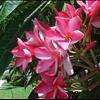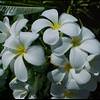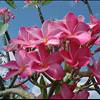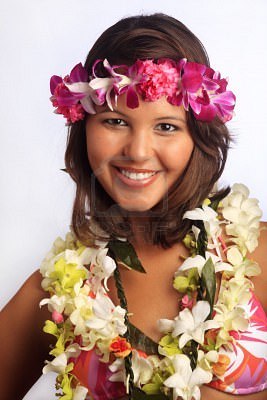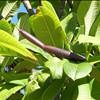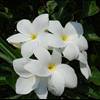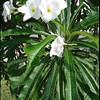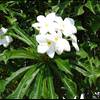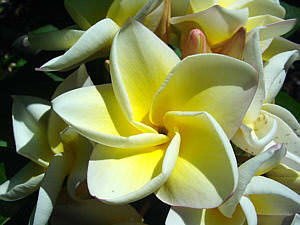This plant may be available to buy
Click the banana to see

|
Plumeria click pics to enlarge |
|
Zone 10 Plumeria is the classic Hawaiian leis tree. Its flowers are the ones used to form the colorful, tropical flower necklaces (lei) every tourist to our 50th state wears during at least one beach party Native to Tropical America, from southern Mexico, northern South America and the West Indies, Plumeria is rated a small tree, to about 15-18 feet and is seen in a variety of solid colors and many new mixed colors. We have seen some Plumeria trees grow much larger The flowers are about 2 inches long, arranged in 5 petals, are waxy and fragrant. Plumeria blooms in South Florida in spring and through all the summer months The tree itself is multi-branched and holds thick foliage. The young tree has green wood on the trunk and branches which become more gray as it matures. Seeds look like this... click pic to enlarge Plumeria is related to Oleander, Periwinkle and Allamanda Plumeria has many common names throughout the tropical world including:
Plumeria-Frangipani is deciduous losing all its leaves in winter. It can look awful without its leaves. Here a staghorn fern is growing in this frangipani Folks who feel their Plumeria requires pruning should wait until the dormant period is well along then cut for shape Many who grow Plumeria as a houseplant get very upset in the fall and winter months as the leaves start to look sick and fall off one by one. It's natural. Water should be at absolute minimum during all dormant months Water should be minimal in the landscape as well. An established Plumeria in South Florida probably needs no added irrigation whatsoever with normal rains providing plenty and maybe a little too much. Plumeria blooms better in the Bahamas where they receive less rain inches This tree prefers full sun or shifting shade and hot weather during blooming months. Not too fussy for soil conditions, Plumeria can grow fairly close to the beach, but without full wind. Enriched soil is accepted but very good drainage must be provided The classic Plumeria is the rubra. Rubra can be found with flowers in various tones of red. Other available varieties include:
click pics to enlarge Folks who want to take cuttings, dormant winter months is the right time. Cut pieces about 8-15 inches long and let cut ends air dry a few days. Store your cuttings in a cool, dry, dark place and wait for early spring. You can also seal the dry cut ends with wax (to prevent excess moisture loss). In spring, plant into pots in sterile sandy soil and locate outdoors in sunny warm/hot location. DO NOT try to water into life. Water should is very minimal. After foliage sprouts, you may SLIGHTLY increase water and feed with time released pellet food New are the dwarf Plumerias. The best one we have seen was planted in a 18-inch terra cotta bowl set on a pedestal. Because of the plant's full leaf habit and many stems, it looked somewhat like a bonsai plant. In the spring and summer, it blooms like the standard Plumeria. With blooms at eye level, the dwarf was a real show stopper
Want even more Plumerias? OK, well, go to The Dean Conklin Plumeria Grove, part of the Honolulu Botanical Gardens More? You want still more Plumerias? Geez, OK. Here are Plumerias from the Dean Conklin Plumeria Garden at Koko Crater Honolulu Botanical Gardens More Plumerias are here |
